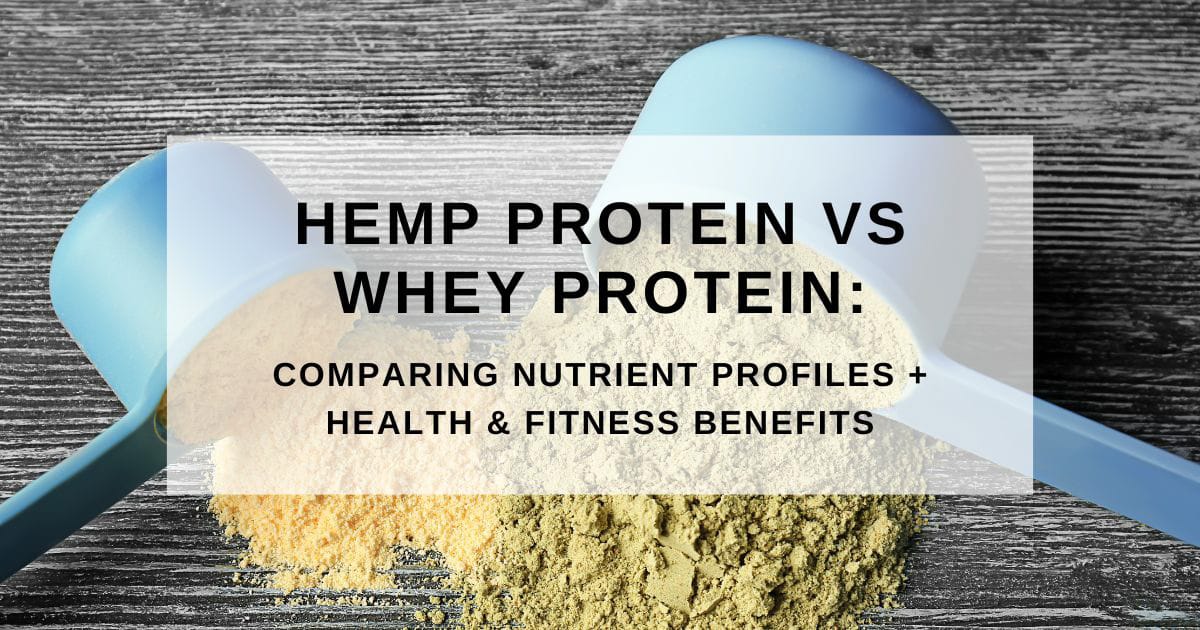Protein supplements are very popular these days as people grow more interested in their health, including meeting their protein needs. We have previously compared pea protein vs soy protein and hemp protein vs whey protein, so here we are comparing several nutritional aspects of pea protein vs hemp protein.
Calories & macronutrients
The macronutrient composition of pea and hemp protein are quite different. Pea protein powder contains around 80-90% protein, while hemp protein powder only contains about 50-60% protein by weight. Hemp protein powder contains significantly more carbohydrates than pea protein powder, though it mostly comes from fiber.
| Calories | Protein | Fat | Carbohydrates | |
|---|---|---|---|---|
| Pea Protein (30 g) | 120 | 27 g | 0.5 g | 2 g |
| Hemp Protein (30 g) | 90 | 15 g | 3 g | 9 g |
Amino acid profile
The amino acids present in food can help determine if it’s a high-quality or low-quality protein. In particular, the essential amino acids are most important because your body cannot make them.
Foods that contain all nine essential amino acids in adequate amounts are considered complete proteins. Complete proteins are ideal, though you can still meet your amino acid needs from incomplete protein sources, which are those that are low in one or more essential amino acids.
Both pea protein and hemp protein contain all 9 essential amino acids, but they are low in at least one, so neither is technically a complete protein.
Pea protein is low in the amino acid methionine (plus cysteine), while hemp protein is low in the amino acid lysine.
However, pea protein is nearly as effective as whey, casein, and egg protein for muscle growth and repair. (1) This is likely due to its overall excellent amino acid profile including high amounts of the branched-chain amino acids (BCAAs), leucine, isoleucine, and valine, which help stimulate muscle protein synthesis.
Branched-chain amino acids
As mentioned above, pea protein has comparable amounts of BCAAs to animal protein sources. Hemp protein, however, is lacking in these essential amino acids, so it may not be ideal as a pre- or post-workout supplement.
Leucine, in particular, is essential for muscle protein synthesis. Pea protein contains more leucine than whey protein which is why it’s seen as a top plant protein source for people interested in gaining muscle mass.
Here, we compare the BCAA content of whey, pea, and hemp protein.
| Leucine (per 100 grams) | Isoleucine (per 100 grams) | Valine (per 100 grams) | |
|---|---|---|---|
| Whey Protein | 3.8 grams | 8.6 grams | 3.5 grams |
| Pea Protein | 5.7 grams | 2.3 grams | 2.7 grams |
| Hemp Protein | 2.6 grams | 1 grams | 1.3 grams |
Protein digestibility
The protein digestibility-corrected amino acid score (PDCAAS) is a method used to compare how well a particular food meets the amino acid requirements for humans and the digestibility of the protein in it.
The digestible indispensable amino acid score (DIAAS) is another method for measuring protein digestibility. It is considered to be more accurate than PDCAAs because it measures the amino acids that make it to the ileum, which is the last portion of the small intestine. Amino acids that don’t make it to the ileum are assumed not to be adequately digested and therefore unusable by the body.
Many plant proteins have decreased bioavailability of protein, vitamins, and minerals, meaning the body doesn’t digest and absorb the nutrients as well as animal proteins. This is typically due to the fiber in plant foods, which can inhibit digestion.
Below, we show the scores for pea protein and hemp protein using PDCAAS and DIAAS. Of note, the scores may differ slightly depending on the specific product used when measuring, so the scores are sometimes reported as a range.
| PDCAAS (0.00-1.00) | DIAAS 100) | |
|---|---|---|
| Pea Protein | 0.89 | 70-80 |
| Hemp Protein | 0.63 | 54-60 |
On a scale of 0.0 to 1.0, the PDCAAS of pea protein is around 0.89, while the PDCAAS of hemp protein is around 0.50. On a scale of 0-100, the DIAAS of pea and hemp protein is around 70 and 54, respectively. (2, 3, 4) This indicates that the body can digest and absorb significantly more amino acids from pea protein than from hemp protein. In comparison, most animal proteins have a score of 1.0 with PDCAAS and 95 or greater with DIAAS.
Vitamins & minerals
Pea protein contains the minerals copper, iron, magnesium, manganese, and sodium, plus vitamins A, B2, B3, B6, B9, C, and K. (5)
Hemp protein powder contains the minerals calcium, copper, iron, magnesium, manganese, phosphorus, and zinc. (6)
Health benefits
The most notable health benefit of pea protein is its nearly ideal amino acid profile for muscle protein synthesis and muscle repair.
Hemp protein contains around 8 g of fiber per 30 g serving. Fiber is important for improving digestion, maintaining healthy gut bacteria, stabilizing blood glucose, and promoting optimal cholesterol levels.
Hemp protein also contains omega-3 fatty acids and gamma-linolenic acid which can help reduce inflammation in the body and the risk for heart disease, arthritis, skin conditions, and cognitive decline.
Taste & texture
Pea protein has a neutral or slight pea flavor and a smooth texture, so it mixes well into smoothies and other foods.
Hemp protein has an earthy, grassy, nutty flavor and a chalky, gritty texture, which may be more noticeable in your recipes.
Cost
Hemp protein tends to cost a bit more than pea protein per serving. And if you’re comparing cost per gram of protein, pea protein is significantly cheaper.
Final thoughts
When comparing total protein content, amino acid profile, taste neutrality, and cost, pea protein is superior to hemp protein. However, if you prefer a higher-fiber protein powder, hemp protein is a better choice.
Want to save this article? Click here to get a PDF copy delivered to your inbox.
This page may contain affiliate links. If you choose to purchase after clicking a link, I may receive a commission at no extra cost to you.
Collette is a registered dietitian and has over a decade of experience working with athletes, children & adults on tube feeding, and people with chronic health conditions. She has been writing about food and nutrition since she was in high school and has a passion for sharing evidence-based information, especially on the topics of protein and the importance of maintaining muscle mass for healthy aging.




